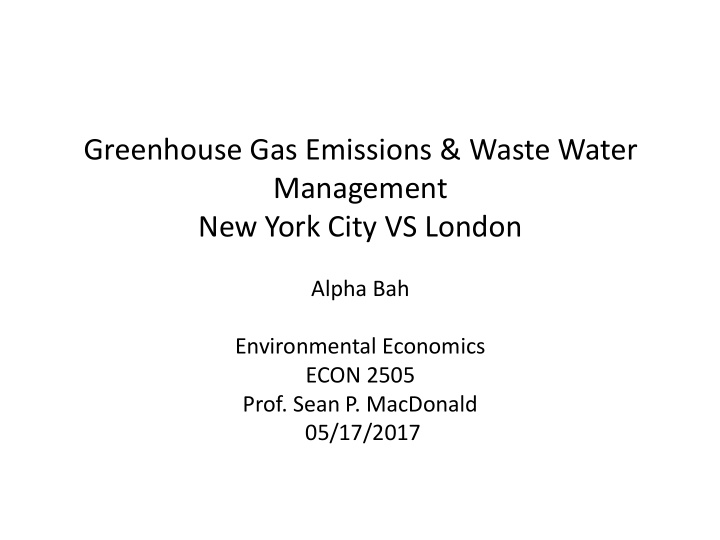



Greenhouse Gas Emissions & Waste Water Management New York City VS London Alpha Bah Environmental Economics ECON 2505 Prof. Sean P. MacDonald 05/17/2017
Greenhouse gases Greenhouse gases are a group of compounds that are able to trap heat in the atmosphere, keeping the Earth's surface warmer than it would be if they were not present. The primary greenhouse gases in Earth's atmosphere are: carbon dioxide , methane , nitrous oxide, water vapor .
New York City New York City has population of 8.5 million, an increase of half a million people since 2000.
New York City GHG Emissions • City buildings accounted for 75 percent of NYC’s total CO2 emissions. • Transportation accounted for 21 percent of NYC’s greenhouse gas emissions
New York City GHG Emissions • New York City has committed to reducing the city’s greenhouse gas emissions by 80 percent over 2005 levels by 2050 (“80 x 50”). • As of 2014, citywide GHG emissions have decreased relative to 2005 levels by 11.7 percent, resulting in citywide GHG emissions of 49.1 million tCO2e (MtCO2e) in 2014.
City Buildings • The nation’s largest landlord — the New York City Housing Authority — has committed to reducing greenhouse gas emissions from its buildings by 30% over the next 10 years . • MATERIAL INCENTIVES • REWARDS • COMPETITION
Transportation • Walking : DOT will continue to install at least 75 accessible pedestrian signals each year • Biking : DOT will create aleast 50 miles of bike routes a year and expand the network of protected bike lanes • Transit: With the MTA, DOT will expand the SBS network to 20 routes citywide
London London is the largest urban area and capital city of the United Kingdom, located in southeastern Great Britain on the River Thames. With a latitude of 51.5074° N, 0.1278° W London's population is estimated to be 8.63 million.
Mayor’s Adaptation Strategy • 1 ) Ultra Low Emission Zone • • The local government tackling 2) The future of the Low Emission climate change and waste Zone treatment in many ways: • 3) Making traffic management • cutting London’s greenhouse gas and regulation smarter emissions to limit further climate • 4 ) Helping Londoners tackle air change. pollution and climate • invest in a water management • 5) Driving the uptake of low and sewerage infrastructure emission vehicles system that fit for a world class • 6) Cleaner electricity for city and will also create jobs. London’s transport • 7) Transforming London’s bus fleet • 8) Delivering a zero emission taxi and PHV fleet • 9) Transforming London’s public and commercial fleets • 10) Low Emission Neighborhoods
Improving Air Quality • The Congestion Charge is an £11.50 ($14.57 ) daily charge for driving a vehicle within the charging zone between 07:00 AM and 6:00 PM, Monday to Friday. • Introducing a £10 ($12.67) Emissions Surcharge (dubbed the 'T-charge') on the most polluting vehicles entering central London . The charge would apply to all vehicles with pre-Euro 4 emission and will cost an extra £10 a day on top of the existing Congestion Charge. • Bringing forward the requirement for all double-decker buses to be Ultra Low Emission Vehicle in central London. • London's Congestion Charge Cuts CO2 Emissions by 16%
Air Quality • Launched in 2011, the city-wide electric vehicle charging network has 1,300 charge points across the Capital. • Expanding an innovative Euro bus retrofit program to 3,000 vehicles by 2020 (up from 800) and to more than 5,000 by 2021 • An aim to purchase only hybrid or zero emission double-decker buses from 2018 • Ultra Low Emission Vehicle Delivery Plan: vision for ULEVs to be the preferred option in London for public transport, fleets and private vehicle owners.
Encouraging cycling and walking • New Superhighways • Quietways • New cycle parking spaces
For Building Owner New York City Waste • Expand roof life 2x3 times (up to 60 Water Management years) Green Roof Advantages • Reduce air-conditioning and Heating costs For The Community • Reduce stormwater runoff. • Reduce energy demand. For The environment • Prevent combined sewer overflow. • Remove nitrogen pollution from rain.
New York City Waste Water Management DOT will test the effectiveness of permeable asphalt pavement and permeable concrete sidewalks. These surfaces allow the ground below the pavement or sidewalk to absorb a portion of storm water, reducing runoff into the sewer system.
London's Waste Water Management London use more than 2.6 billion liters Most of London’s water come from the rivers Thames and Lee. An overflow system diverts the excess flow to the Thames. Annually, 32 million cubic meters of untreated sewage is discharged into the river.
Thames Tideway Tunnel • The tunnel is a 24 feet diameter 16 mile long, it will Help to tackle the 39 million tones of untreated sewage • Providing additional sewer capacity to ensure the city has a sewerage system fit for at least the next 100 years
Works Cited • https://www1.nyc.gov/assets/sustainability/downloads/pdf/publications/NYC_GH G_Inventory_2014.pdf • www.nyenvironmentreport.com/nyc-public-housing-to-reduce-carbon-emissions- by-30-percent • www.citylimitslondon.com/downloads/Complete%20report.pdf • www.london.gov.uk/WHAT-WE-DO/environment • www.water-technology.net/projects/water-desalination • Manley (MAR 2017) “NYC Public Housing to Reduce Carbon Emissions by 30 Percent” New York environment Report. Retrieved: 04/17/2017 • New York City Department of Transportation “Strategic Plan 2016” Retrieved: 04/17/2017 • http://www.nycdotplan.nyc/PDF/Strategic-plan-2016.pd • Dr Prashant Kumar “Startling air pollution maps reveal the true extent of rising emissions in the UK” Retrieved 04/17/2017 www.wired.co.uk/article/air-pollution • Mayor of London “Transport Emission Road Map” September 2014 . • MPA in Environmental Science and Policy program at Columbia University’s “Reducing Greenhouse Gas Emissions in New York City” spring 2012 •
Recommend
More recommend